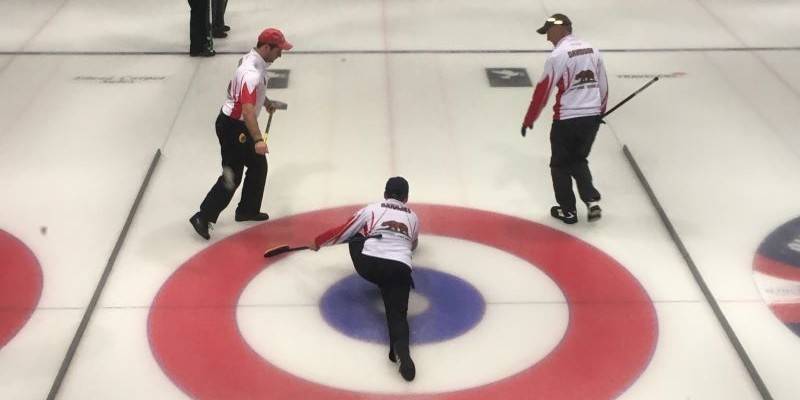Every four years, the nation is captivated by the rather obscure sport of curling. Amid the thrills of the ski jumping and luge and triple salchows, there are men and women playing some sort of large scale bar shuffleboard game on ice. And there’s yelling. A lot of yelling. There is a person in my household who has been known to set an alarm to catch live semifinals of curling at an ungodly hour. So what is it about curling?
Jesus Barajas, an assistant professor of Urban and Regional Planning at the University of Illinois (and Smile Politely writer) is also one of those people who became drawn to the sport while watching the Olympics. He was intrigued by the strategy of it all, and thought to himself, “that’s a sport I could do.” I think that’s the key. We’re not legitimately having those thoughts about other Olympic sports. It’s already years too late to come close to doing what these people are doing. But curling, it’s accessible.
Barajas took the next step and began to search for a club in San Antonio, where he was living at the time. He kept at it after moving to Philadelphia, where he met his wife Kate Garfinkel (now a math teacher at Centennial). She soon took up the sport as well. Barajas and Garfinkel have traveled all over North America to compete, and Garfinkel (pictured at right, below) recently returned from a trip to Austria, where she competed in the Winter World Masters Games.

Image: Four people are standing in an ice rink. There are two men wearing orange and green jackets, and two women wearing blue and red jackets. They are all holding brooms used for curling. There is a target on either side of the group with a blue circle and red circle. Photo from Prairielands Curling Facebook page.
Each time they moved to a new city, they found a club and it became their community. “It’s a true community sport. We spend two hours on the ice, but then you go hang out in the bar after,” said Barajas. It’s that community that they’ve missed after moving to Champaign-Urbana. They’ve been curling with Windy City Curling Club in the south suburbs of Chicago, but began looking into creating one here. Prairielands Curling is now up and running, with their first event happening this Saturday. It’s an open house, free and open to anyone, where you can actually get out on the ice and give curling a shot.
What is it exactly? It’s an extremely old sport, originating in Scotland in the 1500s, where it was played on frozen ponds and lochs. The first American club formed in Michigan in the 1800s, and although it was played as a demonstration sport in several Olympics, it was finally added to the official program in Nagano in 1998.
There are a lot of intricacies to the sport in terms of strategy and scoring, Barajas says it’s often referred to as “chess on ice.” Here’s the gist: You slide 42 pound stones (this number was shocking to me) down the ice, and your goal is to get more of the stones closer to the center of the target than your opponent. There are four players on each team. The last player to throw, the skip, directs the previous three and determines the overall strategy.
An important component of curling is the sweeping; the part with the brooms and the yelling. Garfinkel explained that the players with the brooms are trying to either change the direction of the stone, or help it go farther. The curling “sheet”, or playing surface, is sprayed with water to create frozen droplets or pebbles. Remember how I mentioned bar shuffleboard? It’s like the “salt” on the shuffleboard table. Sweeping flattens the pebbles to smooth out the surface and reduce friction.
If you attend the open house this weekend, you’ll learn more about how it all works, then you’ll have the opportunity to start learning how to throw the stone, and how to slide on the ice. The session will wrap up with a short game so you can try out your new skills.
All of this is to gauge what interest C-U has in the sport. Barajas and Garfinkel are hoping there will be enough to build up their club. They have great support from Windy City, which is supplying equipment and instructors as needed. Barajas says the manager of the U of I Ice Arena has been extremely supportive of adding this to their programming. The downside? There just isn’t a lot of ice time to be had. After this session, it’s looking like April will be the next available slot. In the meantime, they hope to organize social gatherings and watch parties to start building a community. They are also looking down the road to the proposed ice arena in Downtown Champaign, which would open the door for hosting tournaments, or bonspiels as they are called in the curling world.
But for now, they’ll take it one step at a time, beginning with the open house. Garfinkel has been happy with the response so far, in fact at publishing time the registration was full. “I was going around putting up fliers, and everywhere I went people where like ‘yeah this is great!’ It was really cool.”
Garfinkel reiterated how accessible this sport is. She and Barajas are certified wheelchair curling instructors, and stick curling, where you use a long stick to push the stone, is an option for those who aren’t able to crouch all the way down. The upcoming open house is open to all abilities and ages, though keep that whole 42 pound stone in mind.
To keep up with future curling related events, follow Prairielands Curling on Facebook, or email them at [email protected] to be added to their email list.








